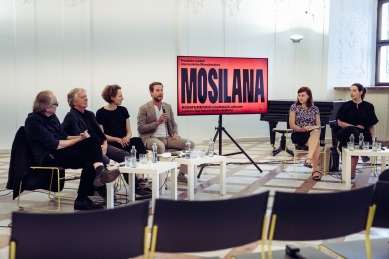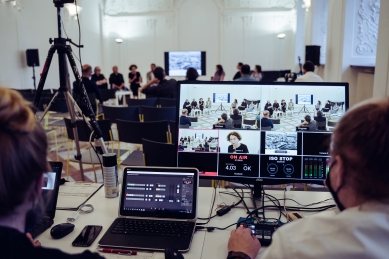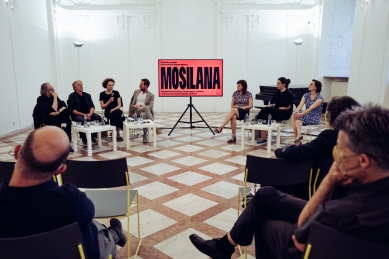
Reflection on the Mosilana Conference
About the values, protection, and potential of industrial heritage
The association Za Brno organized a conference earlier this week on the topic of Mosilany – the last witness of Moravian Manchester. Invited experts who have long been dealing with industrial heritage and the textile industry in Brno brought clear thoughts, arguments, and evidence of what the values of the site consist of and what it could transform into. Representatives of the site owner and the first deputy mayor of the Statutory City of Brno, Petr Hladík, who is also responsible for the city's urban development, accepted the invitation to the conference.
The history of the textile industry, factories, production processes, and techniques was the main topic of the first contribution by Petra Mertová from the Technical Museum in Brno, who captivatingly guided the audience through the history of companies and businesses, their activities, and their coping with historical upheavals.
“The Mosilany site is a remnant of three hundred years of continuous industrial rise in Brno. The textile industry is a symbol of Brno's prosperity and the breeding ground of the jewels that Brno boasts, such as the Tugendhat Villa.”, stated Dr. Mertová.
Writer and author of the book Fabrika, Kateřina Tučková, transported the audience among members of significant factory families like the Offermanns, Schollers, and many others.
“Historical events of the last half-century have robbed Brno of many significant buildings – the Jewish synagogue, the German House. If this happens to buildings that remind us of Moravian Manchester, it will be a sin against future generations. It will be another reason that distances Brno residents from our Czech-German-Jewish roots, which form our identity.”, placed Kateřina Tučková in the context of Brno's history.
The National Heritage Institute was represented at the conference by Michaela Ryšková from the Methodological Center for Industrial Heritage in Ostrava. She acquainted the audience with the architectural development of the site, its urban structure of a city within a city, and the diversity of building types found there. Architect Bruno Bauer, for example, worked here with his invention of a dyehouse structure. She also mentioned examples of good practice from abroad, where model handling of similar sites can be found in Lodz, Poland. “Revitalization of industrial sites connected to watercourses is today a topic of urbanism that is very relevant. Many cities utilize these streams to foster returning life,” highlighted Michaela Ryšková the potential of the site.
Successful examples of the conversion of industrial buildings can also be found in Brno. One successful adaptation of a textile factory was designed by architect Tomáš Šenberger, who demonstrated that factory buildings with floors are fully usable for a range of functions required by investors. He transformed the former Moravan textile factory in Zábrdovice into an apartment building, pleasing the investor. Tomáš Šenberger pointed out the timeless operational solutions of industrial buildings, which are still applied today, for instance, in new administrative buildings on the site of the former Vlněna. Builders are offered countless functional and spatial variabilities. At the end of his presentation, he added: “The conversion of a factory building can turn out economically better than expected. The architect's only task is not to go against the logic of the building.”
Respected Czech architecture historian and industrial archaeologist Benjamin Fragner touched upon the motivations of individual participants. The investor has a legitimate right to invest and profit. Local governance and civil society must define the public interest. All speakers agreed on the necessity of professional dialogue.
“Industrial aesthetics is a phenomenon, a marketable commercial item that has dominated the market in many areas,” added Šipulová in the discussion. Benjamin Fragner stated that a good adaptation of industrial buildings requires time – it’s necessary to proceed step by step. Tomáš Šenberger also agreed with this and added: “It is essential to seek paths for adaptation to be possible. A vision is needed.”
At the end of the moderated discussion, Dr. Fragner posed a question to the present representatives of the Mosilany site owner: “When I entered this room, I had a document in my hand that is a request for the total demolition. If I understand correctly, is there no plan for the total demolition of the entire Mosilany? Or rather I am asking, is there no plan for total demolition? If that were to be the case, it would be a triumph of today's meeting.”
Project manager Ladislav Všetečka took the floor and commented: “I mentioned it here once today too. When you do not know what to do with this site and you are preparing it, you request demolition in the framework of the land preparation. And since we had no information that anything should be preserved, we asked for the entire site. That does not mean that what is permitted to demolish must be demolished completely. If such a dialogue opens up, if a way to utilize those buildings is found, that does not mean that just because you have a demolition order, you must demolish everything. It is more about choosing six buildings to keep, and then we will have the same discussion here as we have today, and you will be asking why you kept these buildings and why you want to demolish these.”
“Let’s take the request for a demolition order as one of the phases of preparing the area. I recognize that if this discussion had not been initiated, we have architectural competitions that counted on preserving fragments. We can develop this further, but how it will turn out in the end? It will definitely not be without some demolition,” added Všetečka.
Next, the new communication manager of the owner took the floor and added to Mr. Všetečka: “We can be even more specific, as Dr. Mertová mentioned. For example, the valuable collections of the Technical Museum could be placed in a new museum of Moravian Manchester, and the steam engine building could easily serve this purpose.”
The National Heritage Institute in Brno submitted a request in April of this year for the declaration of the Cultural Monument to the Ministry of Culture of the Czech Republic. In May, it began proceedings for the declaration of a cultural monument. Representatives of the NPU are convinced of the undeniable urbanistic and architectural quality, along with the historical context of the emergence and evolution of the buildings.
According to the heritage protection law, during the proceedings, the owner must treat the property as if it were already a monument.
Link to the conference recording >
The history of the textile industry, factories, production processes, and techniques was the main topic of the first contribution by Petra Mertová from the Technical Museum in Brno, who captivatingly guided the audience through the history of companies and businesses, their activities, and their coping with historical upheavals.
“The Mosilany site is a remnant of three hundred years of continuous industrial rise in Brno. The textile industry is a symbol of Brno's prosperity and the breeding ground of the jewels that Brno boasts, such as the Tugendhat Villa.”, stated Dr. Mertová.
Writer and author of the book Fabrika, Kateřina Tučková, transported the audience among members of significant factory families like the Offermanns, Schollers, and many others.
“Historical events of the last half-century have robbed Brno of many significant buildings – the Jewish synagogue, the German House. If this happens to buildings that remind us of Moravian Manchester, it will be a sin against future generations. It will be another reason that distances Brno residents from our Czech-German-Jewish roots, which form our identity.”, placed Kateřina Tučková in the context of Brno's history.
The National Heritage Institute was represented at the conference by Michaela Ryšková from the Methodological Center for Industrial Heritage in Ostrava. She acquainted the audience with the architectural development of the site, its urban structure of a city within a city, and the diversity of building types found there. Architect Bruno Bauer, for example, worked here with his invention of a dyehouse structure. She also mentioned examples of good practice from abroad, where model handling of similar sites can be found in Lodz, Poland. “Revitalization of industrial sites connected to watercourses is today a topic of urbanism that is very relevant. Many cities utilize these streams to foster returning life,” highlighted Michaela Ryšková the potential of the site.
Successful examples of the conversion of industrial buildings can also be found in Brno. One successful adaptation of a textile factory was designed by architect Tomáš Šenberger, who demonstrated that factory buildings with floors are fully usable for a range of functions required by investors. He transformed the former Moravan textile factory in Zábrdovice into an apartment building, pleasing the investor. Tomáš Šenberger pointed out the timeless operational solutions of industrial buildings, which are still applied today, for instance, in new administrative buildings on the site of the former Vlněna. Builders are offered countless functional and spatial variabilities. At the end of his presentation, he added: “The conversion of a factory building can turn out economically better than expected. The architect's only task is not to go against the logic of the building.”
Respected Czech architecture historian and industrial archaeologist Benjamin Fragner touched upon the motivations of individual participants. The investor has a legitimate right to invest and profit. Local governance and civil society must define the public interest. All speakers agreed on the necessity of professional dialogue.
“Industrial aesthetics is a phenomenon, a marketable commercial item that has dominated the market in many areas,” added Šipulová in the discussion. Benjamin Fragner stated that a good adaptation of industrial buildings requires time – it’s necessary to proceed step by step. Tomáš Šenberger also agreed with this and added: “It is essential to seek paths for adaptation to be possible. A vision is needed.”
At the end of the moderated discussion, Dr. Fragner posed a question to the present representatives of the Mosilany site owner: “When I entered this room, I had a document in my hand that is a request for the total demolition. If I understand correctly, is there no plan for the total demolition of the entire Mosilany? Or rather I am asking, is there no plan for total demolition? If that were to be the case, it would be a triumph of today's meeting.”
Project manager Ladislav Všetečka took the floor and commented: “I mentioned it here once today too. When you do not know what to do with this site and you are preparing it, you request demolition in the framework of the land preparation. And since we had no information that anything should be preserved, we asked for the entire site. That does not mean that what is permitted to demolish must be demolished completely. If such a dialogue opens up, if a way to utilize those buildings is found, that does not mean that just because you have a demolition order, you must demolish everything. It is more about choosing six buildings to keep, and then we will have the same discussion here as we have today, and you will be asking why you kept these buildings and why you want to demolish these.”
“Let’s take the request for a demolition order as one of the phases of preparing the area. I recognize that if this discussion had not been initiated, we have architectural competitions that counted on preserving fragments. We can develop this further, but how it will turn out in the end? It will definitely not be without some demolition,” added Všetečka.
Next, the new communication manager of the owner took the floor and added to Mr. Všetečka: “We can be even more specific, as Dr. Mertová mentioned. For example, the valuable collections of the Technical Museum could be placed in a new museum of Moravian Manchester, and the steam engine building could easily serve this purpose.”
The National Heritage Institute in Brno submitted a request in April of this year for the declaration of the Cultural Monument to the Ministry of Culture of the Czech Republic. In May, it began proceedings for the declaration of a cultural monument. Representatives of the NPU are convinced of the undeniable urbanistic and architectural quality, along with the historical context of the emergence and evolution of the buildings.
According to the heritage protection law, during the proceedings, the owner must treat the property as if it were already a monument.
Link to the conference recording >
The English translation is powered by AI tool. Switch to Czech to view the original text source.




0 comments
add comment
Related articles
0
08.06.2021 | Mosilana - conference on industrial heritage
1
15.04.2021 | Proposal for the declaration of the Mosilany site in Brno as a cultural monument
1
07.04.2021 | Brno has suspended the change of the zoning plan to prevent the demolition of Mosilana
4
03.04.2021 | Brno-Central will negotiate with the owner about preserving some buildings of Mosilany











